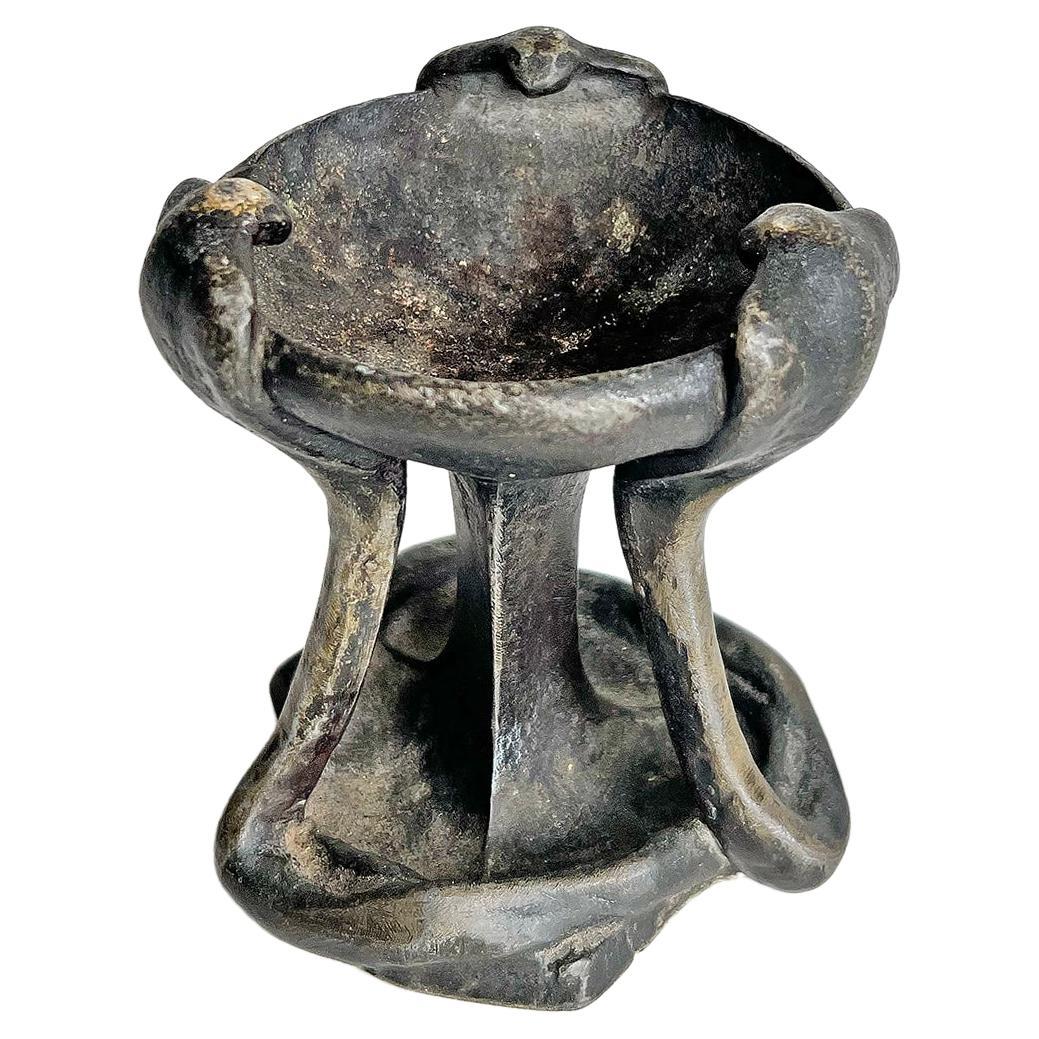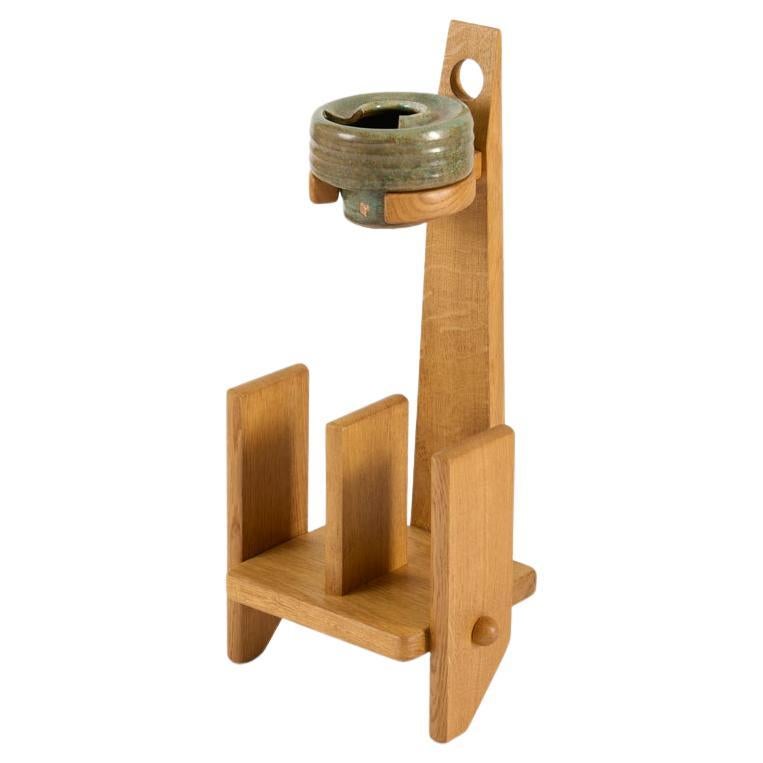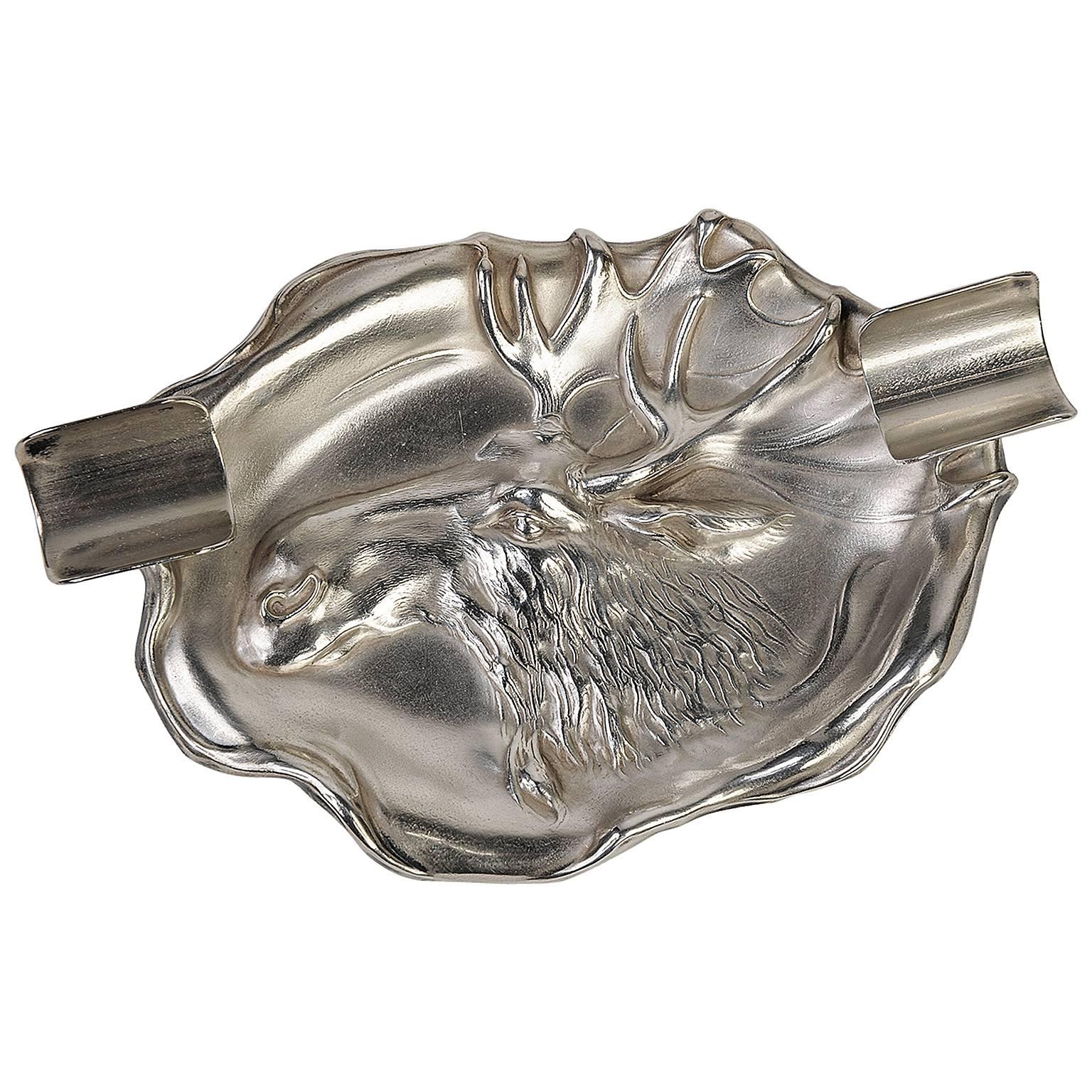Items Similar to Early 20th Century E.T. Hurley Bronze 'Swimming Turtles' Pin Dish Ashtray
Want more images or videos?
Request additional images or videos from the seller
1 of 8
Early 20th Century E.T. Hurley Bronze 'Swimming Turtles' Pin Dish Ashtray
About the Item
This bronze dish was made by multitalented artist and sculptor Edward Timothy Hurley (1869-1950). E.T. Hurley studied at the Art Academy of Cincinnati where he excelled in drypoint etching under the tutelage of noted painter Frank Duveneck. Hurley was also an accomplished painter and went on to work as a decorator for the renowned Cincinnati based Rookwood Pottery company. In addition, the artist produced a variety of work on his own including sketches and works executed in watercolor, pastel and oil. Hurley also worked with metal and sculpted a variety of pieces in bronze.
This bronze dish has a patinated finish designed to resemble that found on ancient bronze works and has a heavily verdigrised appearance. This piece is decorated with a turtle motif and features three turtles swimming in a clockwise direction. The surface of the dish also has a series of concentric rings which add to the illusion that the turtles are swimming on the water.
The dish displays beautifully and retains its original finish. Despite faint marks resembling Hurley's initials on the underside, the artist's mark is indistinguishable but the piece is attributable to Hurley. An unusual and appealing decorative accent.
- Attributed to:E.T. Hurley (Maker)
- Dimensions:Height: 0.5 in (1.27 cm)Diameter: 3.75 in (9.53 cm)
- Style:Arts and Crafts (Of the Period)
- Materials and Techniques:Bronze,Patinated
- Place of Origin:
- Period:
- Date of Manufacture:circa 1920s
- Condition:Wear consistent with age and use.
- Seller Location:Cincinnati, OH
- Reference Number:
About the Seller
4.9
Vetted Seller
These experienced sellers undergo a comprehensive evaluation by our team of in-house experts.
Established in 2011
1stDibs seller since 2015
114 sales on 1stDibs
Typical response time: <1 hour
- ShippingRetrieving quote...Ships From: Cincinnati, OH
- Return PolicyA return for this item may be initiated within 3 days of delivery.
More From This SellerView All
- Early 20th Century Amphora Enameled Pottery VaseLocated in Cincinnati, OHThis striking enameled pottery vase was made by Amphora and is decorated with stylized floral decoration set against a textured ground made up of variegated blue enamel paint on a me...Category
Early 20th Century Czech Art Deco Vases
MaterialsPottery
- Early 20th Century Tiffany Favrile Glass Five-Piece Serving SetBy Louis Comfort TiffanyLocated in Cincinnati, OHThis Tiffany iridescent gold Favrile glass five-piece set includes a fruit bowl and four individual serving bowls. The matched set has cylindrical b...Category
Early 20th Century American Art Nouveau Decorative Bowls
MaterialsGlass
- Early 20th Century Emilio Vasarri Lithograph in Arts & Crafts Wood FrameBy Emilio VasarriLocated in Cincinnati, OHThis rare early 20th century lithograph depicts an image originally executed by Italian artist Emilio Vasarri in 1909. The piece features a scene from classical antiquity and depicts...Category
Early 20th Century Unknown Pre-Raphaelite Prints
MaterialsOak, Paper
- Early 20th Century L.C. Tiffany Furnaces Favrile Art Glass Baluster Form VaseBy Louis Comfort TiffanyLocated in Cincinnati, OHThis early 20th century signed and numbered Favrile art glass vase was made by Tiffany Furnaces. The 12" tall piece has a classic baluster form and is composed of cobalt blue glass. ...Category
Early 20th Century American Belle Époque Vases
MaterialsArt Glass
- 20th Century David Burliuk Neo-Primitive PortraitBy David BurliukLocated in Cincinnati, OHThis vibrant neo-primitive portrait was executed by Ukranian born artist David Davidovich Burliuk (1882-1967). A student of the Kazan School of Fine...Category
Mid-20th Century American Modern Paintings
MaterialsCanvas
- 20th Century Hivo Van Teal Signed Lucite Modernist Abstract SculptureBy Hivo Van TealLocated in Cincinnati, OHThis modernist Hivo Van teal clear Lucite sculpture features two thick four-sided curved arm-like forms which terminate in sharp points. The arms are approximate mirror images of eac...Category
Vintage 1970s American Modern Abstract Sculptures
MaterialsLucite
You May Also Like
- 20th Century, French Ceramic Ashtray by HermesBy HermèsLocated in Royal Tunbridge Wells, KentA ceramic ashtray by Hermes, made in France in the latter half of the 20th century. These ashtrays have always been very collectable with the vintag...Category
20th Century French Ashtrays
MaterialsCeramic
- Ashtray in Bronze, Jugend, Early 20th CenturyLocated in Örebro, SEBeautiful ashtray in bronze, jugend, early 20th Century. Unknown designer and maker. Condition: good, wear consistent with age and use.Category
Early 20th Century Unknown Jugendstil Tobacco Accessories
MaterialsBronze
- Guillerme & Chambron, Oak & Ceramic Ash Tray and Stand, France, Mid-20th CenturyBy Guillerme et Chambron, Votre MaisonLocated in New York, NYRobert Guillerme placed equal emphasis on function and aesthetics, creating a look as staid as it was arresting. While his work was in many ways distinctively conservative and recogn...Category
Mid-20th Century French Mid-Century Modern Magazine Racks and Stands
MaterialsCeramic, Oak
- Unusual Danish Silver Ashtray with ElkLocated in Alessandria, PiemonteUnusual silver ashtray with elk from Denmark: nice object for a writing desk. The reflections of the silver do not allow a clear photo. A/2736 -Category
20th Century Danish Arts and Crafts Ashtrays
MaterialsSilver
- Vintage Edith Heath Mid-Century Modern Large AshtrayBy Heath Ceramics, Edith HeathLocated in North Hollywood, CAVintage Mid-Century Modern ceramic ashtray by Edith Heath Mid-Century Modern large vintage pottery ashtray by Edith Heath for Heath Ceramics....Category
Mid-20th Century American Organic Modern Ashtrays
MaterialsPottery, Ironstone, Stoneware, Ceramic
- Ashtray Crystal, 1950Located in Ciudad Autónoma Buenos Aires, CCrystal We have specialized in the sale of Art Deco and Art Nouveau and Vintage styles since 1982. Why are there so many antiques in Argentina? In the 1880 – 1940 there was a grate wave of immigration encouraged by the periods of war that were taking place. 1st World War took place between 1914 and 1918 2nd World War took place between 1939 and 1945 The immigrants options were New York or Buenos Aires. Tickets were cheap and in Buenos Aires they were welcomed with open arms, as it was a country where everything was still to be done. Argentina was the country of new opportunities, labour was needed and religious freedom was assured, in many cases the of the family travel first until they were settled and then the rest of the family members join them. In the immigrant museum “Ellis Island Immigrant Building” in New York you can se the promotional posters of the boats that would take them to a new life. Between the years 1895 and 1896, Argentina had the highest DGP (gross domestic product) per capita in the world according to the Maddison Historical Statistics index, this situation arose due to the large amount of food being exported to European countries, which were at war. The Argentinean ships left the port of Buenos Aires with food, but they returned with furniture, clothes and construction elements, (it´s common to see this the old buildings of the historic neighbourhood of San Telmo, the beams with the inscription “Made in England)”, as well as many markets that were built in Buenos Aires, such us the San Telmo Market, whose structure was brought by ship and afterwards assembled in 900 Defensa Street. With the great influence of European immigrants living in the country, the children of the upper classes travelled to study in France, resulting in the inauguration of “La Maison Argentinienne”, on 27th of June 1928, in the international city of Paris, which hosted many Argentinians that were studying in Frace. It´s the fourth house to be built after France, Canada and Belgium, being the first Spanish-speaking one. Still in place today (17 Bd Jourdan, 75014, Paris, France). Many of the children of these wealthy families who attended international art exhibitions, museums and art courses abroad, took a keen interest in the European style. This is why Buenos Aires was at the time referred as “The Paris of South America”. Between the years 1890 and 1920 more than a hundred Palaces were built on Alvear Avenue the most exclusive avenue in Buenos Aires. Today some of these palaces have been transformed into museums, hotels and embassies. In the year 1936, the Kavanagh building was inaugurated, it was the tallest reinforced concrete building in South America. During 1994 the American Society of Civil Engineers distinguished it as an “international engineering milestone”, and it´s now considered a World Heritage of Modern Architecture. At the time was common to hire foreign architects such as Le Corbusier, who visited Buenos Aires/Argentina in 1929 and in 1948 he drew up the blueprints for a house built in La Plata City (which was declared a World Heritage Site). In 1947, the Hungarian architect Marcelo Breuer designed “Parador Ariston” in the seaside city of Mar del Plata. After an Argentinean student at Harvard University convinced him to come to Argentina. He worked on an urban development project in the Casa Amarilla, area of La Boca. The Ukrainian architect, Vladimiro Acosta, arrives in Argentina in 1928 and worked as an architect until que moved to Brazil. Antonio Bonet, a Spanish architect who worked with Le Corbusier in Paris, arrives in Argentina in 1937, where he carried out several architectural works and in 1938 designs the well-known BFK chair. Andres Kálnay, of Hungarian origin, made around 120 architectural masterpieces, among which the former Munich brewery stands out, he even made the furniture’s design. The German architect, Walter Gropius, director of the Bauhaus, lived in Argentina, where he wrote articles for “Sur” magazine and founded in Buenos Aires, an architectural firm with Franz Möller, who was also an architect, where he built two houses. At the same time several famous designers decided to immigrate to Argentina, among them we can find the well-known French designer, Jean-Michel Frank, who arrived in the country in 1940 and also worked for the Rockefeller family. Special pieces were made, which were sold exclusively in the country, such as the well-known German company “WMF”, who sold their products by catalogue, which were chosen by the ladies of high society in the list of wedding gifts, as well as the pieces designed by Christofle. The Swiss sculptor Alberto Giacometti, made special pieces for Argentinean mansions. In 1904 the first Jansen branch outside Paris was established in Buenos Aires, as the Argentinean clientele demanded a large amount of furniture, from the end of the 19th century to the mid-20th century. In 1970, the brand Rigolleau Argentina made pieces authorised by Lalique. The brands Maple and Thompson also set up shop in the country. The French plastic artist, Marcel Duchamp moved to Argentina in 1918-1919. Glass signed Gallé, Charder, Leverre, Schneider, Muller and other French firms. They were bought in flower shops and were given to ladies with beautiful floral arrangements. Some furniture manufacturers travelled to international fairs and bough the patterns to produce the furniture in Argentina, such as the furniture firm Englander and Bonta, who bought the patterns ins Italy. It is worth mentioning that in Argentina we have the largest community of Italians outside...Category
Vintage 1950s Italian Space Age Ashtrays
MaterialsCrystal
Recently Viewed
View AllMore Ways To Browse
Found Collectibles
Collectable Pottery
Antique Bronze Art Collectibles
E Initial
Collectible Antique Rings
Bronze Pin
Cincinnati Furniture
Water Dish
Antique Arts And Crafts Ring
Cincinnati Art Furniture
Collectible Antique Pottery
Bronze Ashtray
Ancient Pin
Black Art Ashtray
Bronze Turtle
Metal Turtle
Initial Pins
Pastel Pottery





